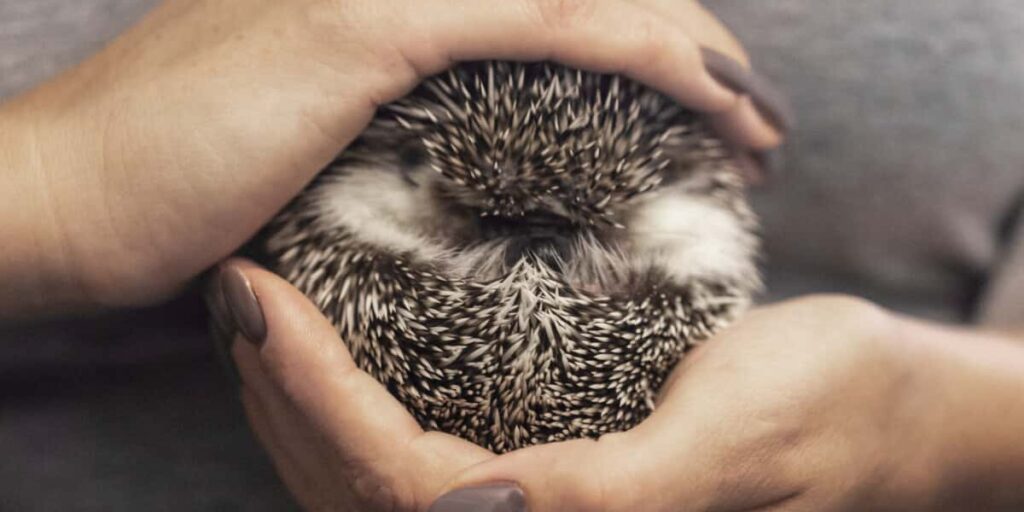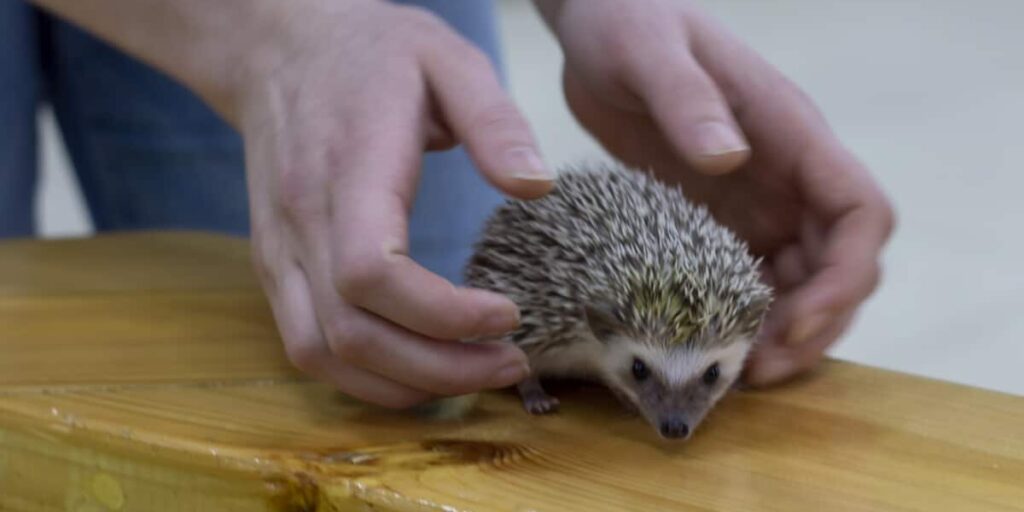Hedgehog quills are as intriguing as they are misunderstood. Wondering if touching a hedgehog feels like cuddling a cactus? Or if hedgehogs shoot poison-filled spikes at their enemies or curl up into prickly balls and roll around? Stop wondering, and read the probably surprising answers to all your hedgehog quill questions.
Hedgehogs are born with soft, white quills, which harden and darken, and are later replaced with adult quills. Their quills are made of the protein keratin, like our hair and nails, and don’t contain poison. Hedgehogs don’t shoot their quills; we can touch these animals without harm.
Surely there’s truth to beliefs that hedgehogs are walking pincushions that shoot poisoned quills on a whim? Let’s explore your top five quill questions in more detail.
Table of Contents
Are Hedgehogs Born With Quills?

Baby hedgehogs (or hoglets) look very different from fully grown ones. Besides being smaller, they’re also a lot less spiky. Just-born hoglets look more like puffy caterpillars than prickly hedgehogs!
Hedgehogs are born with quills, but their quills are hidden under fluid-filled skin for the first hours of their lives. This skin protects their mother from the spikes when she gives birth.
By the end of their first day, hoglets will have lost the protective covering on their back and sides, showing the 150 or so quills underneath. These brand-new quills start white and soft but become harder and darker with time. New quills will also begin to grow. A baby hedgehog will have a full back of quills in just a few weeks.
Within their first six months, hedgehogs experience something called quilling. This is when they lose their hoglet quills and grow harder, stronger adult quills, which give them greater protection against predators. It’s similar to what children go through when they lose baby teeth, allowing adult teeth to take their place.
Adult hedgehogs generally have around 3,000 and 5,000 quills covering their bodies, but some bigger hedgehogs can boast 8,000 or more!
What Are Hedgehog Quills Made Of?
They don’t look like the fur or fluffy hair we expect to find on animals, but hedgehog quills are actually modified hair. They have hair follicles containing a keratin core, the same protein that makes up human hair and fingernails.
Quills are embedded in the hedgehog’s skin and attached to the base muscles. When a hedgehog is threatened, the muscles contract, and the quills stand up. This makes the hedgehog appear larger and more intimidating to predators.
Although they might look dangerous, hedgehog quills are fairly flexible and can be rolled up into a tight ball when the hedgehog is threatened. The quills provide some protection against attack. However, they are not entirely impenetrable and can be broken if enough force is applied.
Do Hedgehogs Have Poison in Their Quills?
It’s a myth that hedgehog quills have poison inside them. However, the quills may have poison on them.
This is why some people get skin reactions from holding a hedgehog. These reactions, known as “hedgie hives,” occur when the quills puncture the skin and release allergens into the body. All sorts of allergens can accumulate on a hedgehog’s body, from dust and poop to food and even hedgehog dander.

Hedgehogs are also known to self-anoint. Self-anointing is a behavior exhibited by hedgehogs when encountering a new or unfamiliar substance. During self-anointing, the hedgehogs will lick or nibble at the substance and then rub it into its quills. Its quills will then be covered in a saliva mix, which can cause an allergic reaction when the quills get in contact with sensitive human skin.
In addition, hedgehogs can carry diseases that can be transmitted to humans, like salmonella, so it’s essential to exercise good hygiene if you come into contact with one of these animals.
So, hedgehogs do not have poison in their quills. However, these sharp quills can still cause problems for some people. If the quills come into contact with the skin, they can push allergens into the body, causing an allergic reaction.
Do Hedgehogs Shoot Their Quills?
You won’t need to dodge flying quills when a hedgehog is near. Hedgehogs have muscles that allow them to raise their quills when they feel threatened, but they cannot shoot them. If a quill becomes detached from the hedgehog, it will eventually grow back.
It’s normal for adult hedgehogs to shed a quill now and then like we lose hairs from our heads, but hedgehogs don’t shoot their quills. They use their quills for defense, not attack.
When feeling threatened, hedgehogs curl into tight, spiky balls, making themselves unappealing prey to prowling predators. While in ball form, hedgehogs stay still.
Whereas porcupine quills detach at a touch, sticking themselves into the bodies of predators that attempt to eat them, hedgehog quills aren’t easily loosened. The tips of porcupine quills are covered in barbs, which make the quills difficult to remove when embedded in an attacking animal’s body. But simpler, gentler hedgehog quills are barb-free.
Do Hedgehog Quills Hurt?

How hedgehog quills feel to the touch is influenced by the hedgehog’s state of mind.
When hedgehogs are anxious, they go into defense mode, poking up their quills and curling into spiky balls to protect themselves. And although you can touch a prickly hedgehog ball without getting injured (it’s rare for their quills to penetrate the skin), this isn’t exactly a pleasant sensation.
The quills have sharp ends, so you’ll probably feel pain if you’re poked, but it shouldn’t be unbearably sore. Some people say quills in this state feel like toothpicks. Young children and people with sensitive skin might experience more pain when poked than people with thicker skin.
When hedgehogs feel calm, however, they lay down their quills, allowing you to stroke them without any nasty prickliness. In this state, the quills feel similar to hairbrush bristles.
Conclusion
So, quills are actually hedgehogs’ hair, hair that does something much more important than giving hedgies an edgy, unusual look.
Although hedgehogs can’t aim and throw or roll their quills towards enemies, their spikes’ protective function is no less impressive. Quills give hedgehogs a nifty survival trick!
